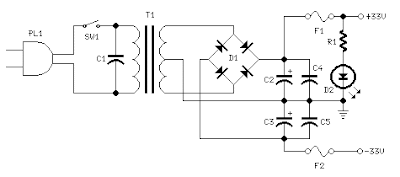Description:
This circuit will illuminate a LED if one of your telephones is in use. It should work in all countries (Including UK) that have a standing line voltage above 48 Volts DC.
Webmasters Note:
Please note that it is illegal to make a physical permanent connection to your telephone line in some countries (this includes the UK and Ireland). If building this circuit it is advisable to use a plugin cord so that the unit can be unplugged should a fault occur. If in doubt consult either your telephone or cable operator.
Notes:
If all extension phones are on-hook and the line voltage is around 48 V, Q1 will conduct thus effectively shorting the gate of Q2 to its source, so it will be off and the LED will be disabled.
Lifting the handset of any phone on the line causes the line voltage to drop to 5-15 V. The gate voltage of Q1, equal to some 6% of the line voltage, will then be too low and Q1 will be turned off. So Q2's gate is now biased at approximately 1/2 of the line voltage, Q2 turns on and the LED indicates that the line is in use. The circuit itself is practically invisible to the other telephone devices using the same line.
LED1 must be low-current and its current-limiting resistor must be 2k2 or more. The other components' ideal values may vary slightly, depending on the local telephone line parameters. The circuit is powered off the telephone line.
If other types of MOSFETs are used, the 500k trimmer can be adjusted to ensure that Q1 is biased fully on while the line is not in use (LED1 off), and vice versa. If Q2 is not a BS108 but some other 200 V MOSFET with a higher G-S threshold voltage, it might be necessary to increase the value of the lower (or decrease the value of the upper) one of the two resistors connected to the gate of Q2.
Plain (bipolar junction) transistors can be used instead and the circuit also works fine, but the resistor values are then much lower - letting ten times more microamps of current pass through while the line is not in use, and even this MOSFET design still could not meet formal minimum on-hook DC resistance specifications.
Both prototypes' PCBs were 4x1 cm. The current-limiting resistor for LED1 is 2k2 in both cases. DO NOT ground any of the leads or conducting surfaces in this circuit. A more reliable design would also include some kind of over-voltage protection etc.
Warning:
In their normal course of operation, telephone lines can deliver life-threatening voltages! Do not attempt to build any of the circuits/projects unless you have the expertise, skill and concentration that will help you avoid an injury.
There are also legal aspects and consequences of connecting things to telephone lines, which vary from country to country. Keep away from telephone lines during a lightning storm!
Source: http://www.zen22142.zen.co.uk
































